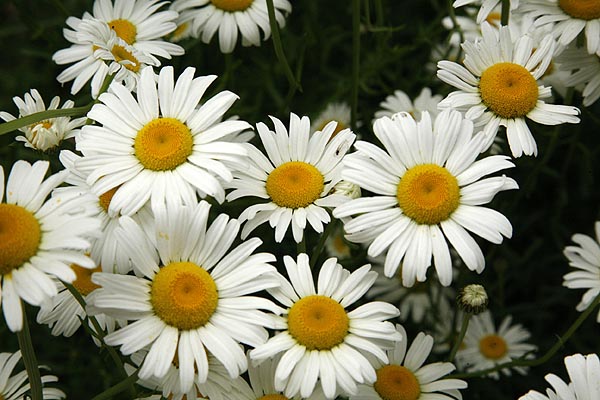A really delightful plant with bright when daisy flowers than can form huge swaths if allowed to grow undisturbed. A perennial hardy to zone 3 but will grow as far south as zone 9. It prefers full sun and poor well drained soil. Ideal for uncultivated areas, tracts, meadows or waste ground. Since the leaves remain green all year in most zones it can make a good ground cover. It tolerates mowing so is easy to maintain. While it is a short lived but will self seed and produce more plants so its usually unnoticed when some plants die. Once established oxeye daisy will provide cheerful white flowers every year with little or no maintenance. A wonderful pollinator plant that attracts butterflies, bees and many other colorful insects to feed on its prolific nectar. Does well in fairly dry soils. Deer and rabbits don't eat it.
Description of OxEye Daisy (Chrysanthemum leucanthemum).
Oxeye daisy is very hardy and its basal glossy mid to dark green laves can stay
green in all but the harshest climates. The leaves are narrow only 0.75"
( cm) wide but very long up to 5" (cm). They are basically oblong with
a rounded end and small spiky sections along each side. This is technically
known as dentate. During late spring long stiff thin stems rise from the leaves.
Smaller leaves cling to these stems in an alternate pattern and often clasp
the stem. These leaves are much smaller than the basal leaves but basically
the same shape and color. Stems usually branch near the base of the plant but
not in the last 12-15" ( cm) when they rise mostly leafless with a few
tiny leaves clinging to the stem at wide separations. The top of the stem is
one single large flower head. Each flower can be from 1- 3" ( cm) across
and is a typical white daisy. 15-34 'petals' that are slightly notched at the
tips and surround a large circular yellow center that consists of numerous tiny
disk florets each of which has 5 tiny lobes at its apex. The plant blooms in
early to mid summer and can last around 30 -45 days. The root system is densely
fibrous and forms offsets from short rhizomes that can form clumps 1-2 feet
( cm) wide. This plant often forms dense colonies where it is allowed to grow
undisturbed.
Growing OxEye Daisy (Chrysanthemum leucanthemum) from Seed.
Sowing Indoors: Plants like some light to germinate so cover extremely
lightly with fine potting mix, using a sieve to get a fine even coating. For
more details see our general growing
instructions. Seeds usually germinate in about 10-30 days in temperatures
around 59 to 68°F (15 to 20°C). Transplant when seedlings are large
enough to handle and gradually harden off in shaded areas before exposing to
full sunshine.
Plant out in desired location after all risk of frost has past. Space 12 to
18in (30 to 45cm) apart or more as plants will expand greatly over time.
Sowing Direct: Seeds can be sown directly if desired. Best sown either
in spring or fall. Prepare bed and remove all weeds that will complete with
the new plants. Sow seeds either in rows no more than ½" (12 cm)
deep. Alternatively seeds can be generally scattered for a more natural look.
If choosing this method collect a pile of soil before you begin. When seed has
been broadcast use a sieve (NOT one from the kitchen) to shake soil over the
top of the area of seeds and cover them lightly.
No matter which method you choose place sticks, tape or some other marking system
to indicate where you have planted your seeds. Water using the mist setting
on the hose daily until the seedlings appear and grow large enough to change
to the spray setting. When seedlings reach 3" in height watering can be
reduced unless there is no rain.
Location and Care of OxEye Daisy (Chrysanthemum leucanthemum).
Prefers a sunny location in well drained poor soil. It most likes sandy soil
and does not tolerate moist wet or rich soils. Ideal for areas of dry ground
that needs covering. Does not do well if the soil is too rich so areas that
have been underdeveloped are ideal.
Very tough and hardy will give a great ground cover once established. Will easily
self seed and increase in numbers. Foliage will stay green in most zones usually
up to around 4b or 5 at most unless the winter is particularly harsh.
Once the plants have finished flowering they can be mown down with a conventional
mower. This will often bring on a second flush of flowers just on shorter stems.
If plant spreading is desired leave mowing until plants have seeded otherwise
cut down just
after flowering finishes.
Medical uses of OxEye Daisy (Chrysanthemum leucanthemum).
The young leaves can be used in salads and a tea made from the whole plant has
been used as a home remedy to treat asthma and whooping cough. A distilled water
made from the flowers is an effective eye lotion in the treatment of conjunctivitis.
Caution.
While an enchanting flower some states consider it as a noxious weed because
it will spread through meadows and pasturelands. It is not a threat to intact
prairies and savannas, but readily invades disturbed ground. Domestic animals
will eat it but this may impart an off-flavor to their milk. The plant can have
a disagreeable odor to some people when cut or crushed. It can also invade lawn
grasses and may become a problem as it tolerates mowing.
Other names.
marguerite, field daisy, white daisy, moon daisy, moon-penny, dog daisy










